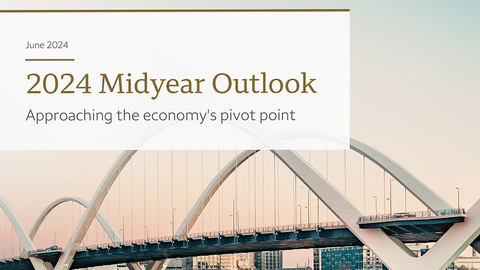Wells Fargo Investment Institute Identifies Five Pivot Points for the Markets
Wells Fargo Investment Institute (WFII) has released its 2024 Midyear Outlook titled 'Approaching the Economy’s Pivot Point.' The report highlights economic and market forecasts, favored sectors, and top portfolio ideas for the next 18 months.
WFII attributes the positive market momentum at the start of 2024 to factors such as AI advances, anticipated Fed rate cuts, declining inflation, and durable earnings growth. The five key points identified include declining inflation, shifting interest rate expectations, increased liquidity, potential for future earnings growth, and global geopolitical shifts.
Forecasts include a U.S. GDP growth target of 2.5% for 2024 and 2.1% for 2025, a consumer price inflation target of 3% for both years, S&P 500 Index targets of 5,100-5,300 for 2024 and 5,600-5,800 for 2025, and anticipated interest rate cuts. The outlook also emphasizes high-quality investments in both equities and fixed income.
- WFII expects U.S. GDP growth of 2.5% for 2024 and 2.1% for 2025.
- Target for U.S. consumer price inflation is set at 3% for 2024 and 2025.
- S&P 500 Index price target ranges are 5,100-5,300 for 2024 and 5,600-5,800 for 2025.
- Anticipates interest rate cuts: two in 2024 and one in 2025.
- Increase in liquidity reflected by all-time highs in major indices like the S&P 500, Nikkei 225, and DAX.
- Positive expectations for earnings growth to support additional gains in major equity indices.
- WFII emphasizes high-quality investments in both equities and fixed income due to geopolitical risks and market volatility.
- Anticipates durable earnings growth driven by AI advances and anticipated Fed rate cuts.
- Inflation remains above the Fed's target of 2-2.5%, expected to hover around 3%.
- Market has shifted expectations, now anticipating fewer Fed rate cuts in 2024.
- Increased geopolitical risks with ongoing conflicts in the Middle East and Ukraine.
- Slowing growth in China presents a headwind for emerging market equities.
- The U.S. dollar remains stronger than expected, which could affect global trade dynamics.
- Economic slowdown expected to cool inflation but may impact consumer spending and business investments.
Insights
Wells Fargo Investment Institute (WFII) provides a forward-looking framework that could be highly relevant for investors strategizing for the upcoming 18 months. Key highlights include expectations for GDP growth, interest rates and inflation. The outlook places considerable emphasis on the anticipated Federal Reserve rate cuts, forecasting two cuts later this year and another in 2025. This could affect the cost of borrowing and subsequently influence investor behavior, particularly in fixed-income and equity markets.
Another area of interest is the equity market forecast. WFII's S&P 500 Index targets suggest a bullish outlook for the next two years, despite the current volatile geopolitical landscape. Even though the U.S. economy is forecasted to grow at a moderate pace, the projections for major equity indices hint at continued market optimism. However, it's important to remain cautious, as such predictions hinge on a variety of factors, including geopolitical stability and economic policies.
Given these insights, the most pertinent takeaway for retail investors is the anticipated shift in market conditions due to macroeconomic factors like interest rates, inflation and geopolitical developments. An investor would need to consider diversifying their portfolio to mitigate potential risks while capitalizing on identified growth opportunities.
The WFII's report touches upon key aspects that can significantly influence market movements. One such element is liquidity; the report details how extensive liquidity in the market has pushed asset prices to all-time highs. This phenomenon can provide both opportunities and risks. For instance, while high liquidity might drive asset prices up, it also raises the question of sustainability, especially if liquidity diminishes.
The focus on earnings growth is another critical point. WFII anticipates broad-based earnings growth, which could sustain upward trends in major U.S. equity indices. Investors should note that earnings growth is a vital driver of stock prices. The optimistic earnings forecast can potentially offer lucrative opportunities, yet one should be wary of overvalued stocks that might not meet earnings expectations.
Furthermore, WFII's attention to the global landscape suggests that international factors, such as geopolitical tensions and economic slowdowns in major economies like China, could have ripple effects on global markets. Investors with international portfolios should stay updated on these geopolitical developments and consider their potential impact on emerging market equities and the strength of the U.S. dollar.
This comprehensive outlook can help investors make more informed decisions by understanding the interplay between domestic and international factors that could shape market trends over the next 18 months.
From an economic perspective, WFII's report offers a nuanced view of the current and future state of the U.S. economy. Key insights include the projected GDP growth rates of 2.5% for 2024 and 2.1% for 2025. These figures indicate a moderate growth trajectory, which suggests that the economy is not overheating and could provide a stable environment for investment.
The outlook on inflation is also notable. WFII expects inflation to stabilize around 3% for the next two years, which, while above the Fed's target range, suggests that extreme inflationary pressures might be subdued. This could offer a more predictable economic environment, but investors should still be cautious as higher-than-target inflation can erode purchasing power and affect real returns on investments.
Additionally, the mention of interest rates staying relatively high compared to initial expectations highlights the importance of understanding how monetary policy can impact investment decisions. Higher interest rates typically increase the cost of borrowing, which can affect everything from corporate profitability to consumer spending. For retail investors, this could mean reassessing their exposure to interest rate-sensitive sectors.
Understanding these macroeconomic indicators can help investors gauge the broader economic environment, enabling them to make more strategic investment decisions aligned with anticipated economic trends.
The WFII 2024 Midyear Outlook highlights economic and market forecasts, favored sectors, top portfolio ideas for the next 18 months

Wells Fargo Investment Institute 2024 Midyear Outlook (Graphic: Wells Fargo)
-
Inflation — Consumer Price Index inflation has decreased from a high of
9.1% in June 2022 to a range of3% –4% . TheU.S. economy is slowing this year and should further cool inflation and prompt Fed rate cuts. As we look out 18 months, our base case calls for inflation to drift mildly lower but struggle to land the Fed’s2.0% to2.5% target. - Interest rates — Coming into this year, markets anticipated as many as five or six interest rate cuts. Now at midyear, the market has shifted expectations and anticipates fewer 2024 Fed rate cuts and projects continued higher interest rates.
-
Liquidity — In the first half, we saw the effect of government stimulus packages and a ballooning federal budget deficit on asset prices as large amounts of liquidity were pumped into the economic engine. That led to all-time highs in the S&P 500 Index, Japan’s Nikkei 225 Index, Germany’s DAX Index, bitcoin, and gold. Even strong issuance of
U.S. Treasuries andU.S. investment-grade corporate bonds was met with robust demand as liquidity actively searched for a home across all asset classes. -
Earnings — Equity prices generally reflect expectations for future earnings growth, and there is the potential for more broad-based growth going forward. We expect earnings growth to support additional gains over the next 18 months for the major
U.S. equity benchmark indices. -
Global landscape — Possibly the greatest potential for a market-moving pivot comes on the world stage. The war in the
Middle East has escalated, and the war inUkraine continues. Also, slowing growth inChina has been a headwind for emerging market equities, and theU.S. dollar has remained stronger for longer than most expected.
“As we recalibrate our outlook for the back half of 2024, our guidance remains focused on high-quality investments in both equities and fixed income,” said Darrell Cronk, chief investment officer for Wells Fargo Wealth & Investment Management. “Quality investments have performed well — and we expect that will continue — as geopolitical risks, market volatility, and November elections will have much to say about the path for markets in the second half of the year.”
Highlights of WFII’s forecast include:
-
The anticipated
U.S. GDP (gross domestic product) growth target for 2024 year-end is2.5% , and2.1% for 2025. -
The target for
U.S. consumer price inflation in 2024 and 2025 is3% . - The S&P 500 Index price target range is 5,100 – 5,300 for year-end 2024 and 5,600 – 5,800 for 2025.
-
Two interest rate cuts are anticipated later this year and one again in 2025. The Federal funds rate forecast for 2024 is
4.75% –5.00% and4.50% –4.75% in 2025.
The full report provides guidance for investors to help navigate the next 18 months, economic and market forecasts, where WFII sees opportunity, and five portfolio ideas. Also included are insights about equities, fixed income, real assets, and alternative investments. Please see the full report for detailed information.
Join the WFII 2024 Midyear Outlook call today, June 12 at 4:15 p.m. Eastern Time. Dial-in: 877-601-6604; Passcode: 71-306-44.
A summary of the WFII 2024 Midyear Outlook is available (PDF).
Investment and Insurance Products are: |
|
● |
Not Insured by the FDIC or Any Federal Government Agency |
● |
Not a Deposit or Other Obligation of, or Guaranteed by, the Bank or Any Bank Affiliate |
● |
Subject to Investment Risks, Including Possible Loss of the Principal Amount Invested |
Risk Disclosure
Forecasts and targets are based on certain assumptions and on our current views of market and economic conditions, which are subject to change.
All investing involves risks, including the possible loss of principal. There can be no assurance that any investment strategy will be successful and meet its investment objectives. Investments fluctuate with changes in market and economic conditions and in different environments due to numerous factors, some of which may be unpredictable. Asset allocation and diversification do not guarantee investment returns or eliminate risk of loss.
Stock markets, especially foreign markets, are volatile. A stock’s value may fluctuate in response to general economic and market conditions, the prospects of individual companies, and industry sectors. International investing has additional risks including those associated with currency fluctuation, political and economic instability, and different accounting standards. This may result in greater share price volatility. These risks are heightened in emerging and frontier markets. Investments in fixed-income securities, are subject to market, interest rate, credit, liquidity, inflation, prepayment, extension, and other risks. Bond prices fluctuate inversely to changes in interest rates. Therefore, a general rise in interest rates can result in a decline in the bond’s price.
The information contained herein constitutes general information and is not directed to, designed for, or individually tailored to, any particular investor or potential investor. This report is not intended to be a client-specific suitability analysis or recommendation, an offer to participate in any investment, or a recommendation to buy, hold, or sell securities. Do not use this report as the primary basis for investment decisions. Consider all relevant information, including your existing portfolio, investment objectives, risk tolerance, liquidity needs, and investment time horizon.
About Wells Fargo Investment Institute
Wells Fargo Investment Institute, Inc. is a registered investment adviser and wholly owned subsidiary of Wells Fargo Bank, N.A., a bank affiliate of Wells Fargo & Company.
About Wells Fargo
Wells Fargo & Company (NYSE: WFC) is a leading financial services company that has approximately
Additional information may be found at www.wellsfargo.com
LinkedIn: https://www.linkedin.com/company/wellsfargo
PM-11282025-6650017.1.1
News Release Category: WF-ERS
View source version on businesswire.com: https://www.businesswire.com/news/home/20240611208807/en/
Media
Sarah Kerr, 917-588-5919
sarah.kerr@wellsfargo.com
Source: Wells Fargo & Company







